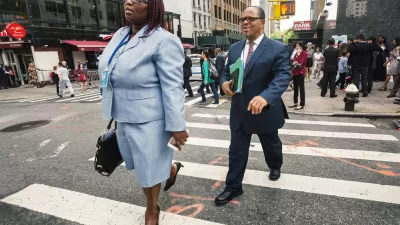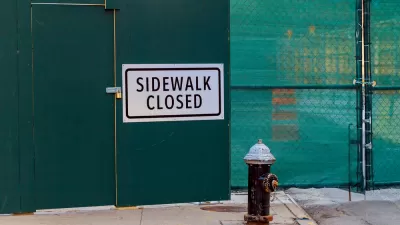Although leaders in the Twin Cities seem to agree on the need to improve the appeal of city streets for those on foot, turning those words into actions seems difficult. Bill Lindeke offers three easy solutions that don't involve touching the street.
Though 'improving walkability' seems to be in every comprehensive plan developed in Minneapolis and St Paul, when it comes time for implementation it's a different story. Bill Lindeke explains, “when it comes down to any one particular project, the situation seems to change. A proposal goes out for traffic calming (say, on South Nicollet Avenue), and all of a sudden each parking space becomes crucial to the city’s economy, each lane of asphalt becomes vital to the regional transportation network, and (I’m sorry but) there’s no money to do anything at this time.” So, when it comes to improving sidewalks for enhanced pedestrian safety, “talk is cheap, and change is hard, and that goes double for concrete," he writes.
In light of the reluctance by cities to explore changes to the actual roadway, such as “road diets, sidewalk extensions, [and] lane narrowing”, Lindeke proposes three alternatives for improving pedestrian safety that can be achieved at little expense: adding red light cameras, installing "no turn on red" signs, and banning the use of cell phones while driving.
For Lindeke, these are no-brainers -- simple and inexpensive solutions that make immediate progress in supporting traffic calming, promoting walking, and increasing safety. He concludes, “All of these tactics are the equivalent of 'calling the bluff.' Sure there are some political challenges, but if cities and governments really meant what they said, they’d do one or all of these things."
FULL STORY: Three Ways to Improve Walkability Without Touching the Street

Alabama: Trump Terminates Settlements for Black Communities Harmed By Raw Sewage
Trump deemed the landmark civil rights agreement “illegal DEI and environmental justice policy.”

Study: Maui’s Plan to Convert Vacation Rentals to Long-Term Housing Could Cause Nearly $1 Billion Economic Loss
The plan would reduce visitor accommodation by 25% resulting in 1,900 jobs lost.

Why Should We Subsidize Public Transportation?
Many public transit agencies face financial stress due to rising costs, declining fare revenue, and declining subsidies. Transit advocates must provide a strong business case for increasing public transit funding.

Paris Bike Boom Leads to Steep Drop in Air Pollution
The French city’s air quality has improved dramatically in the past 20 years, coinciding with a growth in cycling.

Why Housing Costs More to Build in California Than in Texas
Hard costs like labor and materials combined with ‘soft’ costs such as permitting make building in the San Francisco Bay Area almost three times as costly as in Texas cities.

San Diego County Sees a Rise in Urban Coyotes
San Diego County experiences a rise in urban coyotes, as sightings become prevalent throughout its urban neighbourhoods and surrounding areas.
Urban Design for Planners 1: Software Tools
This six-course series explores essential urban design concepts using open source software and equips planners with the tools they need to participate fully in the urban design process.
Planning for Universal Design
Learn the tools for implementing Universal Design in planning regulations.
Smith Gee Studio
Alamo Area Metropolitan Planning Organization
City of Santa Clarita
Institute for Housing and Urban Development Studies (IHS)
City of Grandview
Harvard GSD Executive Education
Toledo-Lucas County Plan Commissions
Salt Lake City
NYU Wagner Graduate School of Public Service




























